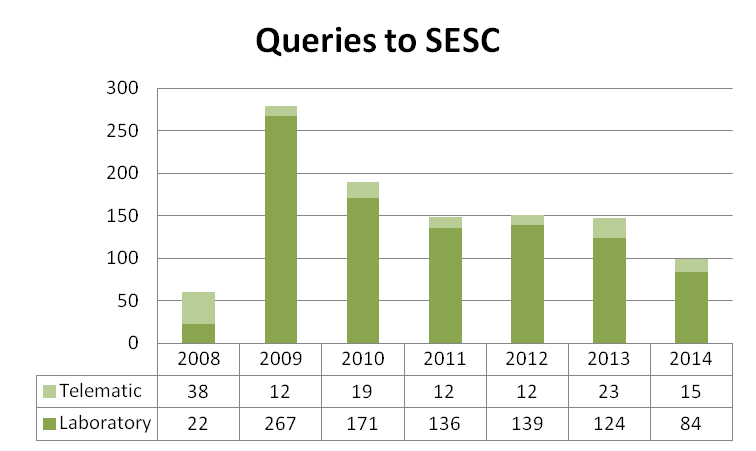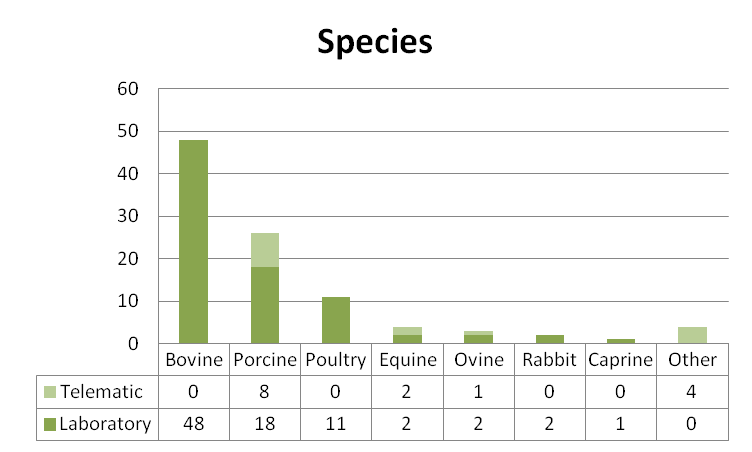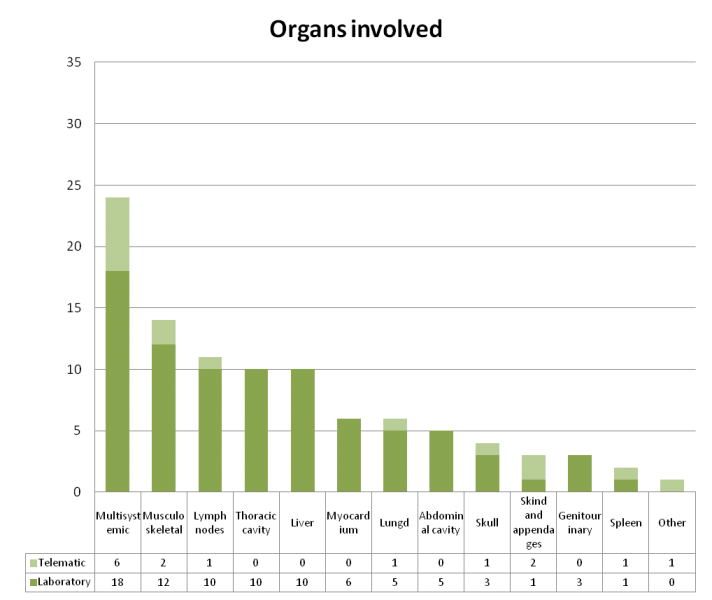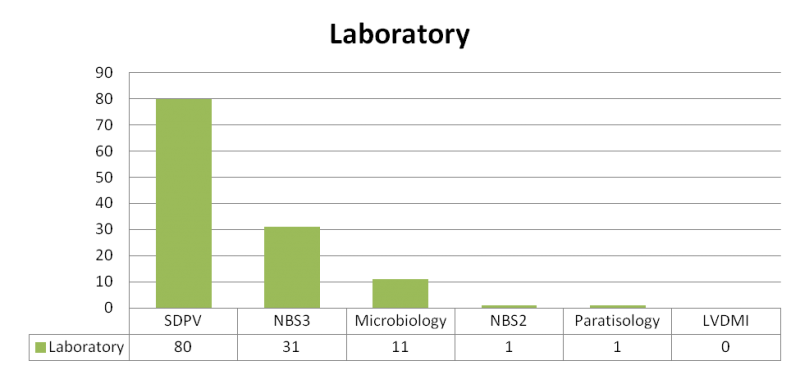Year 2014 summary
During 2014, 22 entries have been published in this blog in Catalan, Spanish and English language. Four of them were diagnostic challenges. A total of 36.644 visits with a total of 82.030 page views have been recorded.
Below is a summary of the data from this year. Once again, we take this opportunity to acknowledge the cooperation and efforts of pathologists and animal health experts in CReSA, the SDPV, and the UAB Faculty of Veterinary Medicine, as well as that of the Public Health Agency of Catalonia (ASPCAT) staff, especially the veterinary meat inspectors whose contributions make the success of this page possible.

Evolution of the number of queries submitted to SESC. The number of consultations has decreased by 33% compared to last year, especially regarding those including laboratory analysis.

Species distribution of the consultations arrived at SESC. The beef sector, once again, is the one contributing with the most samples, especially for diagnosis confirmation of zoonoses such as tuberculosis and bovine cysticercosis. The pork industry continues positioned as the one with the largest number of purely telematics queries . Most poultry samples were submitted to confirm Marek's disease. The "Other" category includes multispecies queries, a query on a boar and one about an insect larvae found in the slaughterhouse.

Organs distribution of the inquiries received. Within the category of multisystemic we allocated, for example, samples to confirm Marek's disease. Most samples of muscle/myocardium were submitted to confirm a diagnosis of cysticercosis.

Distribution of the samples according to the diagnostic service. SDPV: veterinary pathology diagnostic service. BSL3 biocontainment level unit 3 in CReSA. NBS2 CReSA conventional laboratories. The Veterinary bacteriology and mycology service (SVBM) and the parasitology laboratories are from the veterinary school at UAB. LVDMI: Veterinary Diagnostic Laboratory for Infectious Diseases. The same query can generate different samples in the same service or different services
|
Table 1: SUSPECTED CASES and DIAGNOSES |
|||
|
Initial suspect in query |
Number of queries |
% Suspect confirmation |
ALTERNATIVE DIAGNOSES |
|
32 |
50% (16/32) |
Fungal granulomas (4)
Granulomatous suppurative lesions (Nocardia spp) (2) Neoplasia (3) (Squamous cell Carcinoma (1); Mesothelioma (1) Lymphoma (1)) Unspecific granuloma (2) Chronic proliferative peritonitis (1) Abscess (Trueperella pyogenes) (1) Parasitic granuloma (1) Fibrinopurulent pneumonia (1) No lesions (1) |
|
|
Cysticercosis |
15 |
60% (9/15) |
Eosinophilic myositis (1)
C. tenuicollis (1) Peripheral nerve sheath tumour (1) Granulomatuos-suppurative glositis (1) Embolic-metastatic myocarditis (1) Local arterial hypertrophy (1) |
|
Marek’s disease |
8 |
87.5% (7/8) |
Polyserositis (1) |
|
Table 2: Summary of 2014 queries and diagnosis |
||
| Category |
N |
DETAIL |
|
Infectious |
31 |
Tuberculosis (16)
Marek’s Disease (7) Bacterial granuloma (Nocardia Spp.) (2) Bacterial Hepatitis (1) Amyloid arthritis (Enterococcus spp.) (1) Abscesses due to T.pyogenes (1) Catharral suppurative bronchopneumonia (Pasteurella multocida) (1) Abscess (Pasteurella multocida) (1) |
|
Neoplasia |
12 |
Lymphoma (6)
Squamous cell carcinoma (1) Melanoma (1) Nephroblastoma (1) Mesothelioma (1) Peripheral nerve sheath tumour (1) |
|
Parasitic |
18 |
Cisticercosis bovina (9)
Besnoitiasis (1) C. tenuicollis (1) C. pisiformis (1) Ascaris suum hepatitis (1) Parascaris equorum (1) Drone fly (Eristalis tenax) (1) Parasitic granuloma (1) Parasitic hepatitis (1) Eosynophílic myositis (1) |
|
Inflammatory |
8 |
Unspecific granuloma (2)
Vegetable foreing body serositis (1) Chronic proliferative peritonitis (1) Granulomatuos-suppurative glositis (1) Polyserositis (egg yolk peritonitis) (1) Fibrinous-suppurative pneumonía (1) Embolic-metastatic myocarditis (1) |
|
Fungal |
4 |
Fungal lymphadenitis (4) |
|
Other |
18 |
No diagnosis (skin lesions in pig carcass) (3)
No diagnosis (other) (3) Cystic lymphadenosis (1) Splenic torsion (1) Splenic atrophy (1) Liver hyipoxia (1) No lesions (1) Local arterial hypertrophy (1) Samples to rule out Progressive atrophic rhinitis (P.multocida -ve) (1) Serous cyst (1) Elithelial cyst (1) |
|
Non diagnostic queries |
8 |
On cadmium toxicity (1)
On wild boar susceptibility to filaria (1) On pig dermatits (1) On late evisceration of pig carcasses (1) On the necropsy protocol for pigs (1) On delayed carcass evisceration (1) On trichinella susceptibility of domestic species (1) On visual-only inspection of pig carcasses (1) |


2 comment(s)
Bon any! (més val tard que mai)
I a seguir treballant en aquesta eina tant interessant per nosaltres!
Us demanaria que ens poséssiu més a prova amb un major nombre de reptes diagnòstics. Estic fart de veure abscessos i pernils trencats.
Salut!
Gràcies Pau, Igualment! Prenem nota!